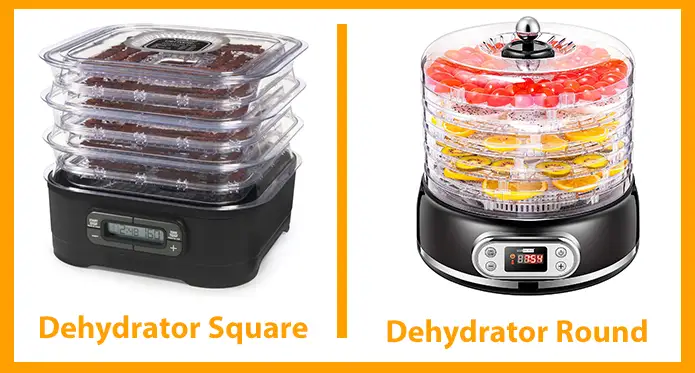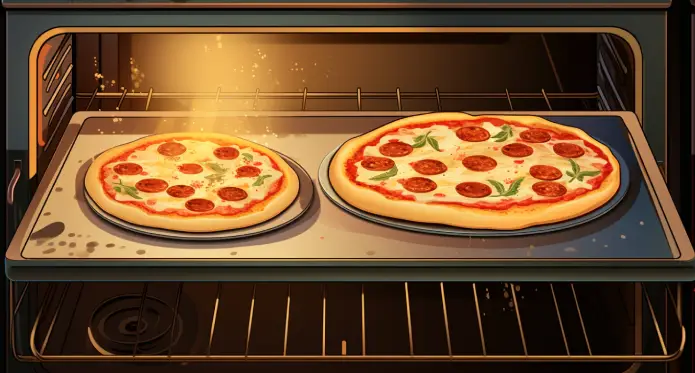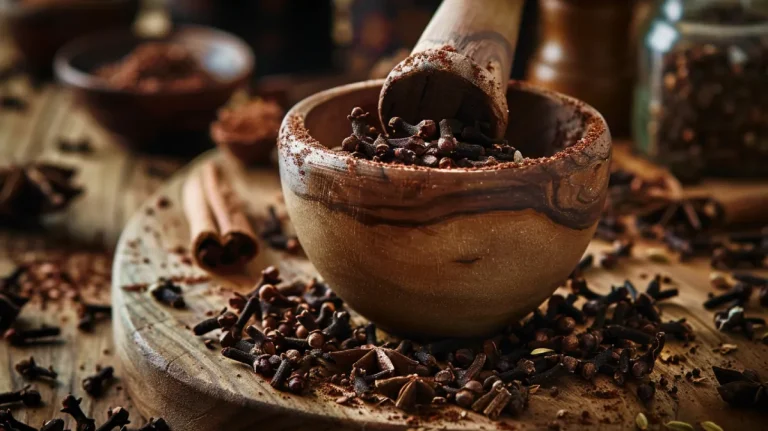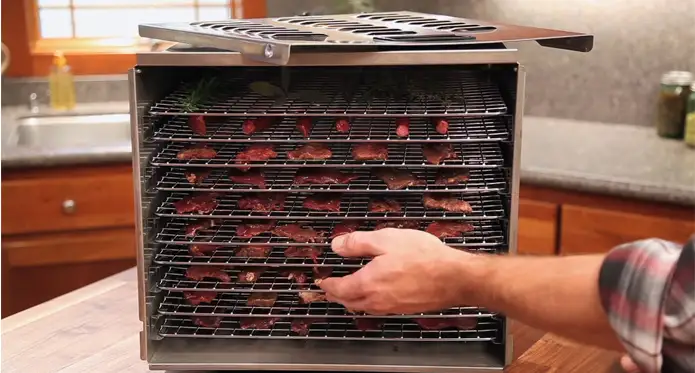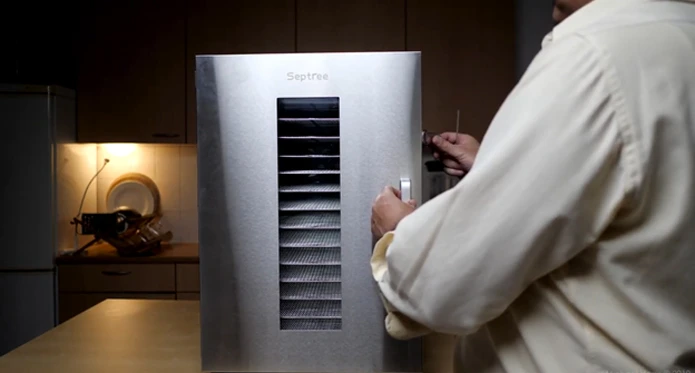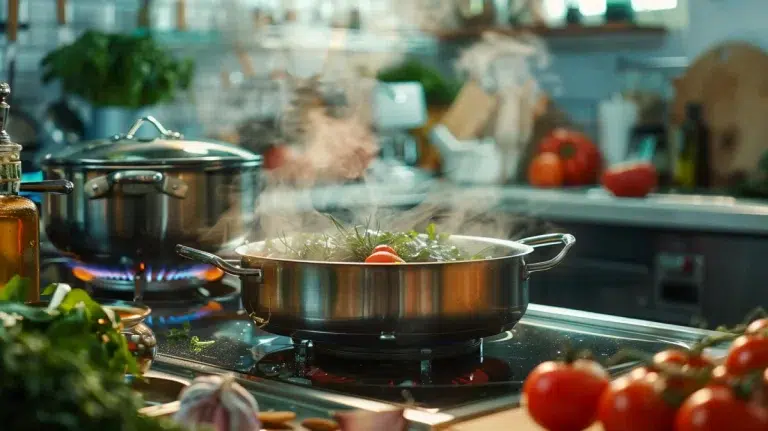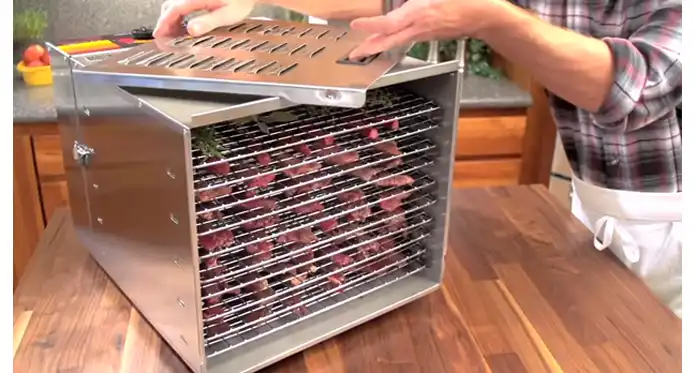Dehydrator Square VS Round: Total 6 Differences
During dehydration, bacteria and other microorganisms can’t grow, making it a highly effective method for preserving food. But when choosing a dehydrator, you’ll have to decide whether to get a square or round model.
While both have advantages and disadvantages, you should consider your specific needs before investing. If you have limited countertop space, a square dehydrator will fit more easily in your kitchen. Alternatively, round dehydrators are more energy efficient and less time-consuming.
It depends on your individual needs which type of dehydrator is best for you. This article will assist you in making the correct choice of dehydrator square or round and which one is suitable for your needs, so read on.
Dehydrator Square vs Round: Differences
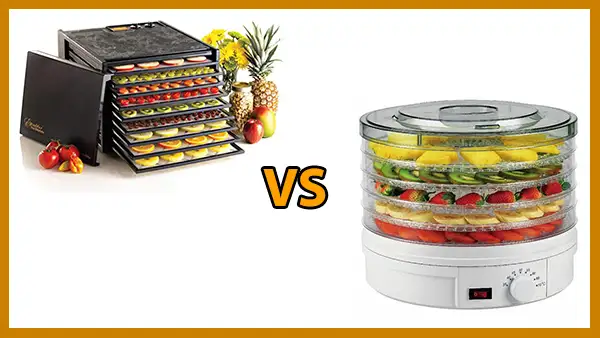
As far as dehydrators are concerned, there are two main types available on the market: square and round. There are pros and cons to both, so selecting the one that is most suitable for your needs is imperative.
Here’s a closer look at the primary differences between square and round dehydrators:
Construction & Overall Design
The construction of a square dehydrator is very different from that of a round dehydrator. The most obvious difference is the shape of the unit. A square dehydrator has four sides, and a round dehydrator has a circular shape.
Though both square and round food dehydrators serve the same purpose, they differ in design. Square dehydrators are more compact and efficient since they use space better. They also typically have more shelves, which means you can dry more food at once.
On the other hand, round dehydrators are generally taller, which can make them a bit difficult to store. But, they often come with wheels, so you can move them around easily. Also, round food dehydrators typically have fewer shelves than square models, but the shelves are larger, so you can fit more bulky items.
Airflow
The other significant difference is how air flows through the unit. The way that air flows through a dehydrator can have a considerable impact on how quickly and evenly food dries.
Dehydrators with square or rectangular shape typically have fans that are located at one end of the unit, near the control panel. This design causes the air to flow straight from the fan across the trays and out the other side. Thus, food closest to the fan will dry more quickly than food towards the end of the drying cycle.
Round dehydrators typically have bottom-mounted fans, which circulate air upward in a spiral pattern. This type of airflow tries to evenly dry all levels of food at once, resulting in more consistent results.
Food Loading
Food-loading system can make the dehydrating process much more manageable. Round dehydrators typically have a central loading spindle that can be used to hold trays in place. This design makes it easy to add or remove trays as needed, and it also allows for better airflow around the food.
Square dehydrators often have side-loading doors. While this design makes it a bit more difficult to add or remove trays, it does help to keep heat and moisture from escaping the unit.
Size & Capacity
Regarding size and capacity, square dehydrators typically have more space than their round counterparts. This is because they have a larger footprint and can be stacked higher without compromising air circulation. Hence square dehydrators are ideal for large families or those who enjoy preserving large quantities of food.
Typically a round dehydrator’s round shape reduces per tray capacity by 20 percent to 45 percent compared to a square tray. These dehydrators are less compact and often come with expandable trays that allow you to increase capacity as needed.
Drying Speed
During the drying process, the food’s surface area and airflow within the dehydrator determine the drying speed.
Most dehydrators have round trays rather than square ones to maximize airflow. This allows hot air to circulate evenly around the food, ensuring it dries evenly and quickly.
But the lower trays remain warmer because of their proximity to the heating element, so square dehydrators with bottom-mounted fans typically dry food more evenly.
Conversely, square dehydrators have less surface area, requiring less time to dry food. But, square dehydrators have more trays than their round counterparts, which can lengthen the drying time. Also, square dehydrators tend to have more efficient airflow, so they can quickly dry food but consume more power.
So, which is right for you? If you’re looking for a compact and affordable option, go with a square dehydrator. Opt for a round dehydrator if you’re willing to sacrifice some portability for optimal performance.
Advantages and Disadvantages of Square and Round Dehydrator
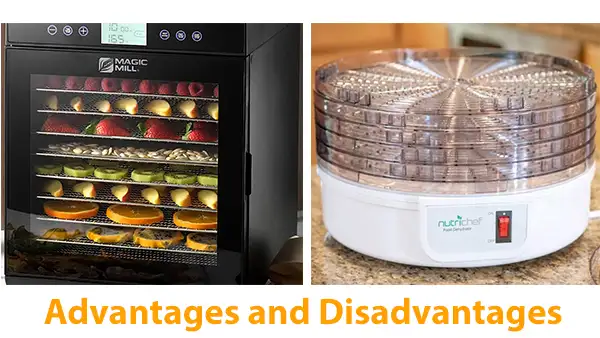
Dehydrators work by removing the water content from food, which prevents bacteria from growing and spoiling the food. Dehydrators come in two main shapes: square and round. Each design has its advantages and disadvantages.
Advantages and Disadvantages of Square Dehydrator
Advantages:
- Total dehydration space: Square trays provide whole dehydration space. This means you can dehydrate more food in less time because there is no wasted space between the trays.
- Fans in the rear: One of the most significant advantages of a square dehydrator is that it allows even drying. This is due to the fan placement in the back, which circulates air evenly throughout the food trays.
- Fit snugly: Square dehydrator stainless steel trays fit snugly into a corner, making them more space-efficient. They also tend to have more racks than round dehydrators, so more food can be dried at once.
And because the racks are square (such as an Excalibur dehydrator), you can make better use of the space by cutting food into smaller pieces.
- Stress-free food placement: Regarding food placement, a square dehydrator is much more efficient than its round or cylindrical counterparts. That’s because a square dehydrator has a more flat surface area so that you can fit more food on each tray.
And since the trays are stackable, you can fit a lot of food in a square stackable dehydrator without taking up a lot of counter space.
- Robust construction: As the name suggests, the dehydrator’s body has four sides, with the heating element and fan on one side. These dehydrators are typically more compact & robust than round dehydrators, making them a good choice for those who plan to use their dehydrator frequently.
Disadvantages:
- Requires high power: Square dehydrators have one major drawback: they need a lot of energy to operate. Some models use so much power that they need to be plugged into an electrical outlet.
- Expensive machine parts: While square dehydrators generally have the square footage of drying area compared to round dehydrators, they also tend to be more expensive. The square dehydrators have more complex machine parts, such as fans and heating elements.
Advantages and Disadvantages of Round Dehydrator
Advantages:
- Suitable for drying: Round dehydrators are a popular style of dehydrator because they are the right size for most home kitchens. They typically have between four to eight round tray slots, making them large enough to dry a good amount of food but small enough to fit on a countertop or in a cupboard.
- Energy efficient: Round dehydrators are energy efficient because they use less energy than square dehydrators. This is because round dehydrators have a smaller spherical area, requiring less drying time.
- Budget-friendly: A round dehydrator is a great budget-friendly option for those looking to dehydrate food at home. While square dehydrators can be expensive, round dehydrators are more affordable and provide adequate drying space.
- Utilize the required trays: Dehydrating foods in a round dehydrator (such as a Nesco food dehydrator) works well. It utilizes the required trays and has an efficient heating system that helps to keep the food at a consistent temperature. They are also great for making fruit leathers.
Disadvantages:
- Loss of space: One of the most significant disadvantages of a round dehydrator is the loss of space. Unlike square dehydrators, which have a more open design, round dehydrators have a cylindrical shape that limits the amount of space inside by 25 to 40 percent.
- Extra warmer lower trays: Round dehydrators typically have multiple tray levels, with the lower trays being closer to the heating element and fan than the upper trays.
This can sometimes cause extra warmth on the bottom tray with uneven drying, as the lower trays may dry out faster than the upper trays.
Although both types of dehydrators have pros and cons, the square dehydrator is the better choice for those who want to dehydrate large quantities of food at once, and the round dehydrator is better suited for those who wish to dry food on a budget.
Is a Square or Round Dehydrator Better for Meat Jerky?
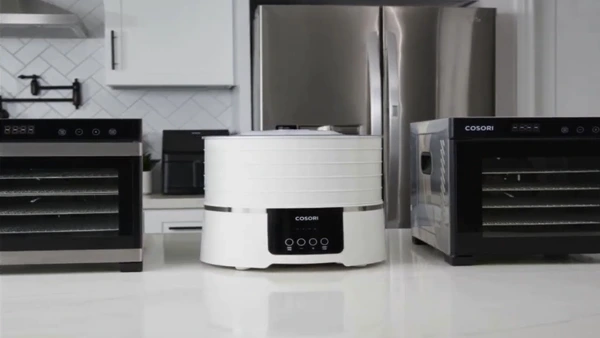
If you’re drying meat to create a jerky, you might wonder what shape of dehydrator is best for the job. The answer is quite simple: a square dehydrator will help to create a consistent drying temperature, ensuring that your beef jerky is safe to eat.
The best way to achieve a consistent drying temperature for meat jerky is to use a square-shaped dehydrator. In reality, round dehydrators circulate less hot air and dry meat less evenly than their circular counterparts. This can result in pockets of wetness where bacteria can grow, making the jerky unsafe to eat.
Also, square dehydrators typically have a more flat surface area, which allows for better air circulation and, therefore, more evenly dried jerky.
But, if you are planning to make fruit leather, fruit roll sheet, or other dried snacks that benefit from a little parsing, a round food dehydrator may be a better option since there is less need for drying.
Does a Square Food Dehydrator Need a Fan?
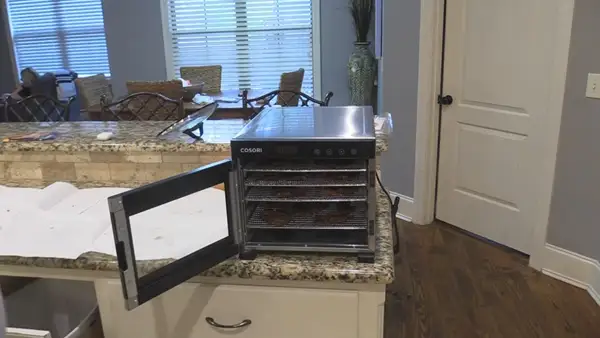
Most square dehydrators do not have a fan, but some models do. A fan helps to circulate air around the food, causing the water to evaporate more quickly. Without a fan, it would take much longer to dehydrate food properly.
Also, fans help distribute heat evenly so that all foods dry simultaneously, preventing food from sticking to shelves. Fans can help to speed up the drying process by circulating air more evenly throughout the dehydrator. But, fans can also add noise and increase the risk of fires, so they are not always necessary.
Do Square Dehydrators Use More Electricity Than Round Ones?
Square dehydrators use more electricity due to their larger size and higher number of trays. This is because they have more surface area and must work harder to heat the food inside. Similarly, square dehydrators often have more shelves to hold more food. Due to this, they require more energy to operate.
But, this doesn’t mean they’re less efficient. Square dehydrators often have a better airflow, so the food dries more evenly. This can lead to less wasted food and better overall results. A round food dehydrator may be the better option if you’re looking to save on your power bill.
Do You Have to Use All the Trays in a Square Dehydrator?
No, you do not need to use every tray in the dehydrator. You can use as many or as few as you like, depending on how much food you need to dehydrate. But remember that dehydration times will vary depending on how many trays are used.
If you use only four or six trays, the food will dehydrate faster than if you are using all of the trays. Also, the food on the lower trays will drain faster than on the upper trays. So, checking the food regularly and removing the dried pieces as needed is essential.
What Temperature Does a Round Rehydrator Run at?
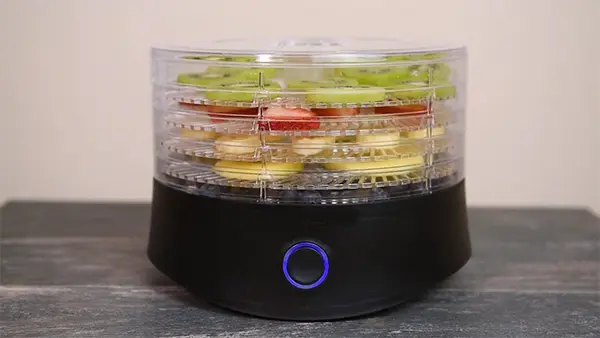
A Round food dehydrator runs at various temperatures, depending on what you are dehydrating. For delicate foods like herbs, dehydration at a lower temperature, such as 95°F, is recommended to prevent overdrying and discoloration.
Meat should be dried to 165°F and then dehydrated between 130°F and 140°F. This will help to prevent the growth of bacteria. For fruits and vegetables, the ideal temperature is between 125°F and 135°F.
Dehydrating food at a higher temperature will cause the water content to evaporate too quickly, resulting in shrinkage and a loss of nutrients. Dehydrating at a lower temperature can help preserve your food’s nutritional value.
Do Round Dehydrators Heat Up More Quickly?
Food dehydrators consist of a heating element surrounded by a drum-shaped chamber. Some experts believe that round food dehydrator base trays heat up faster than other designs because the heating element is near all the food. This allows for more even heating and faster moisture removal at the bottom.
But this can lead to problems if the food is not rotated correctly. The bottom trays can become too dry while the top trays are still wet. So, you should check the food regularly and rotate the trays as needed.
Square and Round Dehydrators, Is it Worth Buying One of These Dehydrators?
Choosing between a square or round food dehydrator may be a dilemma if you are in the market for one. Both types have pros and cons, so you must consider your needs before deciding.
Round dehydrators are less expensive than square models. But, they can be less effective at evenly drying food, and storing large items in a round dehydrator can be more difficult. Conversely, square food dehydrators offer more space for drying food and generally have better airflow.
While both provide good drying support, your preferences will determine the best food dehydrator for you. If you are looking for a food dehydrator on a budget, then a round model may be the way to go. In contrast, a square food dehydrator gives you better results and more space.
You Might Want to Check:

